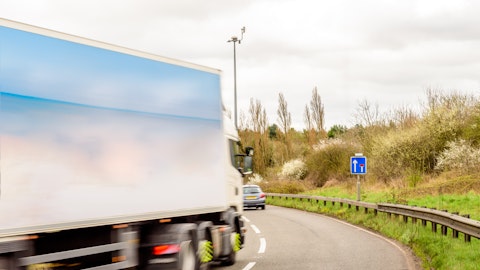Mike Cory: Thanks, Jonathan. One of the wounds just opened up. Look, it’s no different. We have to be really aligned. First of all, we have to understand what our assets and our people can do for us and expand on that, obviously. But I just don’t see the market, the commodities we move being the same as the growth is where I came from. And so, again, I have a long way to go to understand the market and I’m working extremely hard with Kevin to understand it. But look, the principles are the same. We sell a service, we deliver a service. And how fast we recover from any service disruptions is key to keeping the customer knowing that our goal is to be the reliable provider for them. So, I don’t see any difference. And you can go back and take a look at the hockey stick recovery and all that great history, but I’m looking forward.
And I don’t think anything changes in my view as to how we approach this. We know what we can do, and we continue to really stay close. And again, the teams being together from the ground floor up, there shouldn’t be surprises. And if there are, we’re going to build our resiliency so that we can attack it again and again be reliable for the customer. So, I don’t see that big of a difference in terms of the model that we have here or where we have — wherever we have, what we had — what I had before. It’s sell the service, deliver the service. And Kevin is really working hard with his team on ratability. So, there shouldn’t be surprises.
Operator: Your next question comes from the line of Scott Group from Wolfe Research. Please go ahead.
Scott Group: Hey, thanks. Good afternoon. Maybe Kevin, any — just any color on how much of a uptick in the coal yield we should expect in Q4 and into Q1? And then maybe just Sean, just help us think about some of the puts and takes for Q4. It just sounds like better volume, less of a fuel headwind, maybe some met uplift, but maybe some continued cost pressure. So, you put it altogether, that’s — you think operating ratio gets better or worse from Q3? Any directional color you want to give us?
Kevin Boone: Yeah. Scott, there can be a lot of mix issues within our coal business. When you think about Southern utilities, longer length of haul, higher RPU versus Northern utilities. Export coal, very, very good business, can be shorter haul, so can sometimes be a little bit lower RPU as well. But [indiscernible] given some of the benchmark strength that we’ve seen, I would look for something in the low-single digits, maybe mid-single digits depending on mix.
Sean Pelkey: Yeah. And Scott, on your question around Q4, I think you did a good job of kind of summarizing the factors. We’re off to a good start in terms of the volume, and that’s obviously one of the most important factors in terms of not only seeing OR stay stable to improve, but also more importantly growing our earnings. As you mentioned, fuel should be a little bit less of a negative here in Q4 than it was in Q3. We’ll see what the direction of fuel prices is, but we have $30 million lag in the third quarter that we don’t expect to repeat. And then in terms of the cost, seasonally, we typically do see higher costs in Q4 than Q3. So, if you were to look over the last five years, each and every one of those years, the OR has been worse in Q4 than Q3, and everything except for 2020, the COVID year, operating income has been down sequentially from the third quarter.
Now, we’re off to a good start like I said, and we’ve got our eyes fixed on places that we can eliminate waste and control costs. So I think we’ve got a good shot of bucking that seasonal trend and doing a little bit better than that.
Operator: Your next question comes from the line of Justin Long from Stephens. Please go ahead.
Justin Long: Thanks, and good afternoon. Kevin, it sounds like you’ve recently had some early success with market share gains both truck and rail. But could you expand a little bit more on the commodity groups where you’re seeing the most meaningful tailwinds on that front? And as we move into 2024, where you see the most opportunity to keep that momentum going?
Kevin Boone: Yeah. I think it’s really within our merchandise portfolio and it’s broad-based. There’s different initiatives across the board from our metals side of the business which I highlighted. Automotive has been a good strength for us. And it’s all on the back of service that’s differentiated in the market, and we’ve really been able to capitalize on that with the customer. The customers are looking for reliable service, and I think we’ve been a standout in the market here year-to-date, and our team has been selling it, and it’s been incredibly helpful on that side. I will say we’re going to start to see some benefits of the industrial development side, more in probably the ’25, ’26, but you’ll start to see that layer in, in late ’24 and got a lot of momentum there.
And again, it goes back to the service product that we’ve been able to deliver and getting the confidence as these industries build new plants that are locating on our railroad. So, I actually just sat down with Christina this afternoon, and we were going through all the industrial projects that have been taking place throughout the U.S. And it’s interesting, you look at a map holistically throughout the U.S. and it’s almost focused on the East and that’s all railroad. That’s where we operate and that’s where our team is really going after it today. And I’m very, very optimistic on what’s happening in that side. So, a lot of opportunities. They are mixed across different industries, and every industry is created a little bit different, but we are being able to lean into those conversations, quite different environment than what was occurring last year, but very, very optimistic here.
Operator: Your next question comes from the line of Amit Mehrotra from Deutsche Bank. Please go ahead.





